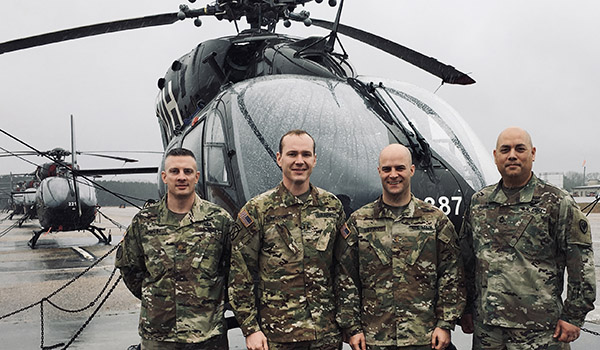
Branch Chief’s Update / By BG M. Todd Hunt: In 2013, to promote Total Force integration the Army created a position for an Army National Guard Deputy Commanding General (DCG-ARNG) to serve as a member of the USAACE headquarters command group.
The role of the DCG-ARNG is to serve as the principle advisor to and representative of the Commanding General (CG), USAACE for ARNG equities across the Aviation Branch.

U.S. ARMY NATIONAL GUARD PHOTO
The DCG-ARNG also serves as the liaison between USAACE and the Director, ARNG and Chief, National Guard Bureau (NGB). The DCG-ARNG is responsible to the CG USAACE to provide ARNG Aviation considerations in the areas of leader development, doctrine, training, force structure, readiness and mobilization. The DCG-ARNG has a full-time staff of four military personnel located on the second floor of the USAACE headquarters at Fort Rucker. The Aviation enterprise is encouraged to work directly with the DCG-ARNG office to facilitate increased readiness across the Aviation Branch. As an Aviation enterprise it is imperative our branch work as a Total Force, especially with force structure and modernization efforts on the horizon. The DCG-ARNG office points of contact are COL Brett Criqui, MAJ Jay Ryun, CW5 Dennis Smith, or SGM Jorge Rodriguez at 334-255-3531.
Functions of the USAACE RC Liaison Office
The DCG-ARNG also oversees the USAACE Reserve Component (RC) Liaison office at the Battalion level, consisting of three full-time military personnel collocated with the 1-145th Aviation Battalion at Fort Rucker. The USAACE RC Liaison office receives, in-processes, and manages Guard and Reserve Soldiers attending courses at Fort Rucker and the Explosive Ordnance Disposal course at Eglin Air Force Base. The preponderance of their student load is for the Initial Entry Rotary Wing (IERW) course. On any given day, there are approximately 450 IERW, 80 Initial Entry Training (IET), and 40 functional training RC students attending courses here. The RC Liaison office is a place Guard and Reserve students can seek assistance with academic tutoring, career counseling, special emphasis physical fitness training, and administrative actions involving NGB or coordination with their home state or unit. The RC Liaison team in coordination with the DCG-ARNG office conduct quarterly town hall meetings with all ARNG IERW students ensuring information is disseminated, to capture systemic issues, and to facilitate networking among fellow students. The RC Liaison team has been highly successful in shepherding and providing support to these students. As a result, the ARNG has enjoyed very high graduation rates across all courses. In FY18, the National Guard executed 302 advanced airframe quotas and 300 Soldiers successfully returned to their state as rated aviators. The RC Liaison points of contact are MAJ Dustin Griffin and MSG Richard Jardin at 334-255-9961.
ARNG Aviators in Flight School
The ARNG will send Aviators to IERW in higher numbers over the next several years. Driving this need for an increase in new pilots is the requirement to offset current pilot losses. The losses are due to a combination of factors including the commercial airlines recruitment of military pilots over the past two years as the economy continues to expand. Increased operational demands placed upon the Active Component (AC) have led to more integration of the ARNG for overseas contingency operations. The ARNG provides approximately 48% of total deployed Army Aviation units in support of world-wide overseas Combatant Command contingency operations. During the FY18 annual Structure Manning Decision Review (SMDR), the ARNG provided data highlighting the need for additional IERW training quotas and the impacts to mission if their request went unfilled. Due to the ARNG’s continued support in deployments and potential loss of Aviators, the Army is allocating 416 IERW training quotas beginning in FY21.
Recruiting is key to building ARNG Readiness
Our Soldiers are our number one weapon system and each state will need to work hard ensuring they recruit qualified pilot candidates to fill these quotas. Beyond just the increase in numbers, recruiters and current unit members must find ways to attract new Soldiers in the absence of the traditional 20-year retirement that ended in January 2018. While some candidates may consider the blended retirement system attractive, it is not yet clear how this will impact recruiting and retention efforts. Officer and Warrant Officer Aviators with over 20 years of service also make up a disproportionately high percentage of the total ARNG Aviation force. Typically, units will recruit and fill from the nearby local communities so that Citizen-Soldiers do not have large commutes for drill weekend or accomplishing flying hour requirements. Convincing this population of the force to stay a bit longer given the opportunities elsewhere can be another challenge for our Senior Leaders. We will continue to build capacity through USAACE at Fort Rucker with this increase in IERW training seats and continue to provide well trained Soldiers for future operations.
Way Ahead
In times of fiscal uncertainty, the ARNG must seek creative ways to achieve higher individual and collective readiness levels. ARNG Aviators and units must be ready when called upon, as readiness is our number one priority. ARNG Aviation Soldiers provide a tremendous capability for our Nation, which is not seen in other forces throughout the world. We must continue to strive in readiness of personnel and maintenance in order to accomplish assigned missions at home or abroad. The Aviation branch is strong because of AC/RC integration and will remain strong because of the dedicated and high-quality Aviation Soldiers we have throughout the branch.
Above the Best!
BG M. Todd Hunt is the USAACE deputy commanding general for Army National Guard.








